How to eliminate PhantomStealer from infected systems
TrojanAlso Known As: PhantomStealer information stealer
Get free scan and check if your device is infected.
Remove it nowTo use full-featured product, you have to purchase a license for Combo Cleaner. Seven days free trial available. Combo Cleaner is owned and operated by RCS LT, the parent company of PCRisk.com.
What kind of malware is PhantomStealer?
PhantomStealer is an information stealer delivered through a malware loader known as JSGuLdr. Once infiltrated, PhantomStealer can harvest various sensitive information from infected devices. These attacks can lead to identity theft, financial loss, and other issues. If PhantomStealer is detected on a device, it should be eliminated immediately.

More about PhantomStealer
As a stealer, PhantomStealer can be designed to steal a wide range of information, including browser autofill data such as saved names, addresses, and credit card details. It may also collect cookies, browsing history, and stored passwords from different web browsers installed on the infected device.
Also, PhantomStealer might include a keylogging feature, allowing it to record every keystroke made on an infected device. This activity typically happens quietly in the background, so the victim does not notice anything unusual. As a result, attackers can gather sensitive details like login credentials, payment information, personal conversations, etc.
Furthermore, many stealers search the entire system for data from messaging apps (e.g., Discord, Telegram, WhatsApp), gaming platforms, FTP clients, VPN software, and other programs. The stolen information can include config files, login tokens, saved credentials, and other important account details.
Moreover, PhantomStealer may target cryptocurrency wallets by locating and grabbing wallet files and other related data. It may be capable of extracting data, such as private keys, seed phrases, or other data. It may also monitor the clipboard so it can capture crypto addresses that users copy.
In addition to the aforementioned data, stealers like PhantomStealer can collect detailed system and network data, such as the operating system version, installed programs (including security tools), and active processes. They may also take screenshots, record audio through the device's microphone, and even upload selected files from the infected machine.
| Name | PhantomStealer information stealer |
| Threat Type | Trojan, password-stealing virus, banking malware, spyware. |
| Detection Names | Avast (FileRepMalware [Misc]), Combo Cleaner (Gen:Heur.Clyp.8), ESET-NOD32 (Python/PSW.Agent.FX Trojan), Kaspersky (UDS:Trojan-PSW.Win32.Agent), Microsoft (Trojan:Win32/Egairtigado!rfn), Full List (VirusTotal) |
| Symptoms | Trojans are designed to stealthily infiltrate the victim's computer and remain silent, and thus no particular symptoms are clearly visible on an infected machine. |
| Possible distribution methods | Infected email attachments, malicious online advertisements, social engineering, software vulnerabilities, software 'cracks'. |
| Damage | Stolen passwords and banking information, identity theft, the victim's computer added to a botnet. |
| Malware Removal (Windows) |
To eliminate possible malware infections, scan your computer with legitimate antivirus software. Our security researchers recommend using Combo Cleaner. Download Combo CleanerTo use full-featured product, you have to purchase a license for Combo Cleaner. 7 days free trial available. Combo Cleaner is owned and operated by RCS LT, the parent company of PCRisk.com. |
Conclusion
PhantomStealer is a type of malware designed to collect sensitive information from an infected device. It poses a serious risk to the user's privacy and security and can lead to issues like monetary loss, account hijacking, and identity theft. It is important to remove such threats as soon as possible to avoid potential damage.
Examples of other stealers are Arkanix, NovaShadow, and SharkStealer.
How did PhantomStealer infiltrate my computer?
PhantomStealer is delivered through a loader, a malicious script identified as JSGuLdr. First, a JScript file runs PowerShell using Windows Explorer components. PowerShell then downloads additional malicious files from Google Drive and stores them in hidden folders within the system.
The downloaded files are encrypted, and PowerShell decodes and runs them in memory only. In the final step, PhantomStealer is injected into msiexec.exe, a legitimate Windows process, so it can run quietly while stealing data. This method of infection is utilized to avoid security protections, making it harder for basic tools to stop it.
The initial infection vector is unknown, however, the malware could be delivered via emails containing malicious files or links, technical support scams, pirated software, malicious ads, cracking tools, keygens, software vulnerabilities, P2P networks, or similar channels.
How to avoid installation of malware?
Keep your operating system, applications, and antivirus software up to date, and perform regular security scans. Exercise caution with emails or messages from unknown sources. Avoid opening attachments or links in such messages. Only download software from official websites or trusted app stores.
Do not click on ads, pop-ups, or other suspicious items on unreliable websites, and do not allow these sites to send you notifications. If you believe that your computer is already infected, we recommend running a scan with Combo Cleaner Antivirus for Windows to automatically eliminate infiltrated malware.
Instant automatic malware removal:
Manual threat removal might be a lengthy and complicated process that requires advanced IT skills. Combo Cleaner is a professional automatic malware removal tool that is recommended to get rid of malware. Download it by clicking the button below:
DOWNLOAD Combo CleanerBy downloading any software listed on this website you agree to our Privacy Policy and Terms of Use. To use full-featured product, you have to purchase a license for Combo Cleaner. 7 days free trial available. Combo Cleaner is owned and operated by RCS LT, the parent company of PCRisk.com.
Quick menu:
- What is PhantomStealer?
- STEP 1. Manual removal of PhantomStealer malware.
- STEP 2. Check if your computer is clean.
How to remove malware manually?
Manual malware removal is a complicated task - usually it is best to allow antivirus or anti-malware programs to do this automatically. To remove this malware we recommend using Combo Cleaner Antivirus for Windows.
If you wish to remove malware manually, the first step is to identify the name of the malware that you are trying to remove. Here is an example of a suspicious program running on a user's computer:
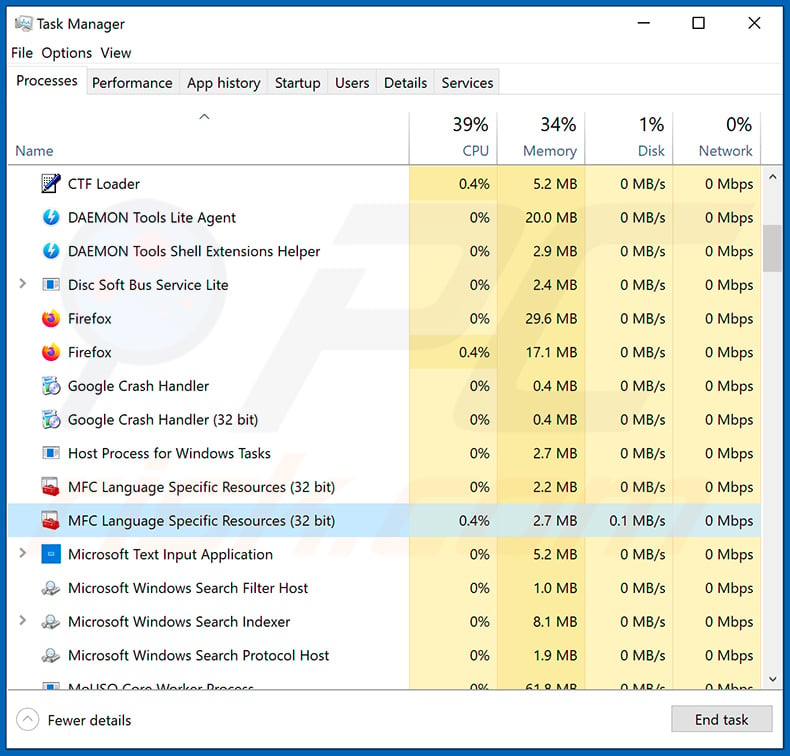
If you checked the list of programs running on your computer, for example, using task manager, and identified a program that looks suspicious, you should continue with these steps:
 Download a program called Autoruns. This program shows auto-start applications, Registry, and file system locations:
Download a program called Autoruns. This program shows auto-start applications, Registry, and file system locations:
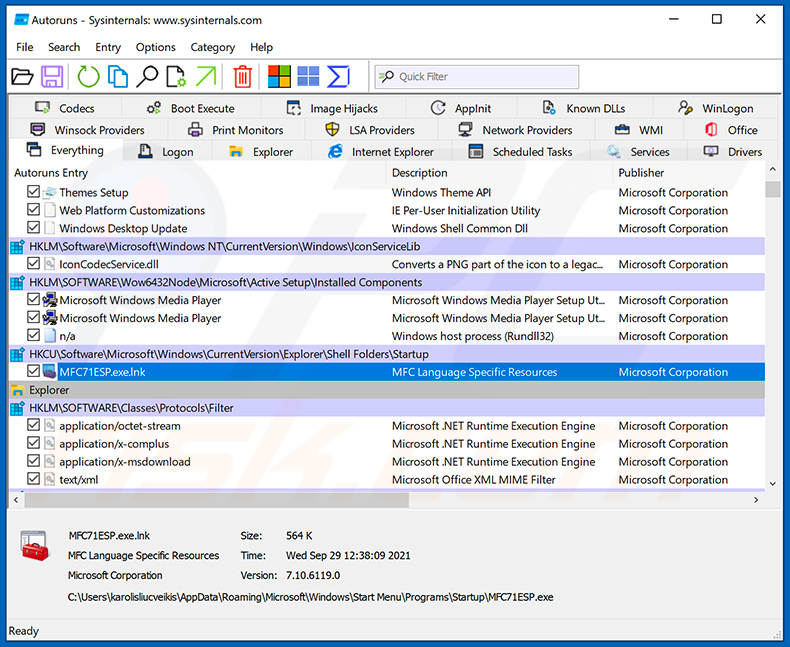
 Restart your computer into Safe Mode:
Restart your computer into Safe Mode:
Windows XP and Windows 7 users: Start your computer in Safe Mode. Click Start, click Shut Down, click Restart, click OK. During your computer start process, press the F8 key on your keyboard multiple times until you see the Windows Advanced Option menu, and then select Safe Mode with Networking from the list.
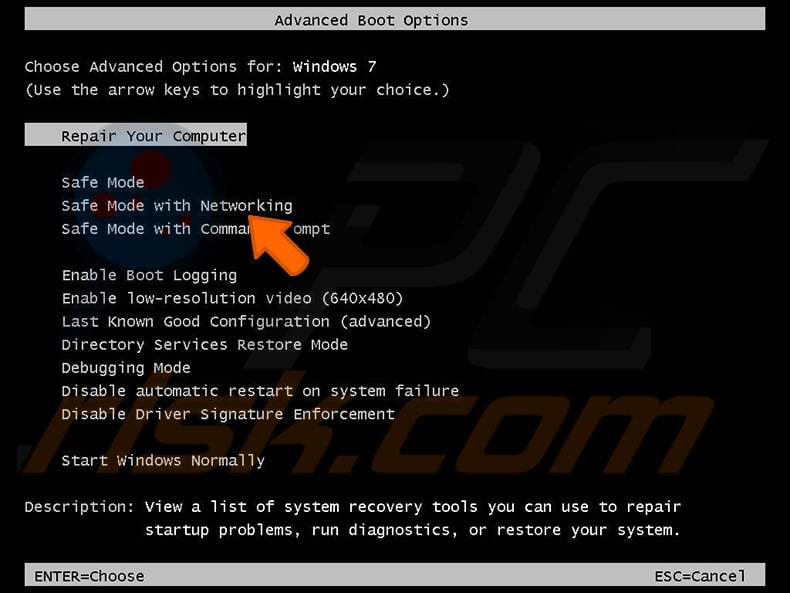
Video showing how to start Windows 7 in "Safe Mode with Networking":
Windows 8 users: Start Windows 8 is Safe Mode with Networking - Go to Windows 8 Start Screen, type Advanced, in the search results select Settings. Click Advanced startup options, in the opened "General PC Settings" window, select Advanced startup.
Click the "Restart now" button. Your computer will now restart into the "Advanced Startup options menu". Click the "Troubleshoot" button, and then click the "Advanced options" button. In the advanced option screen, click "Startup settings".
Click the "Restart" button. Your PC will restart into the Startup Settings screen. Press F5 to boot in Safe Mode with Networking.

Video showing how to start Windows 8 in "Safe Mode with Networking":
Windows 10 users: Click the Windows logo and select the Power icon. In the opened menu click "Restart" while holding "Shift" button on your keyboard. In the "choose an option" window click on the "Troubleshoot", next select "Advanced options".
In the advanced options menu select "Startup Settings" and click on the "Restart" button. In the following window you should click the "F5" button on your keyboard. This will restart your operating system in safe mode with networking.
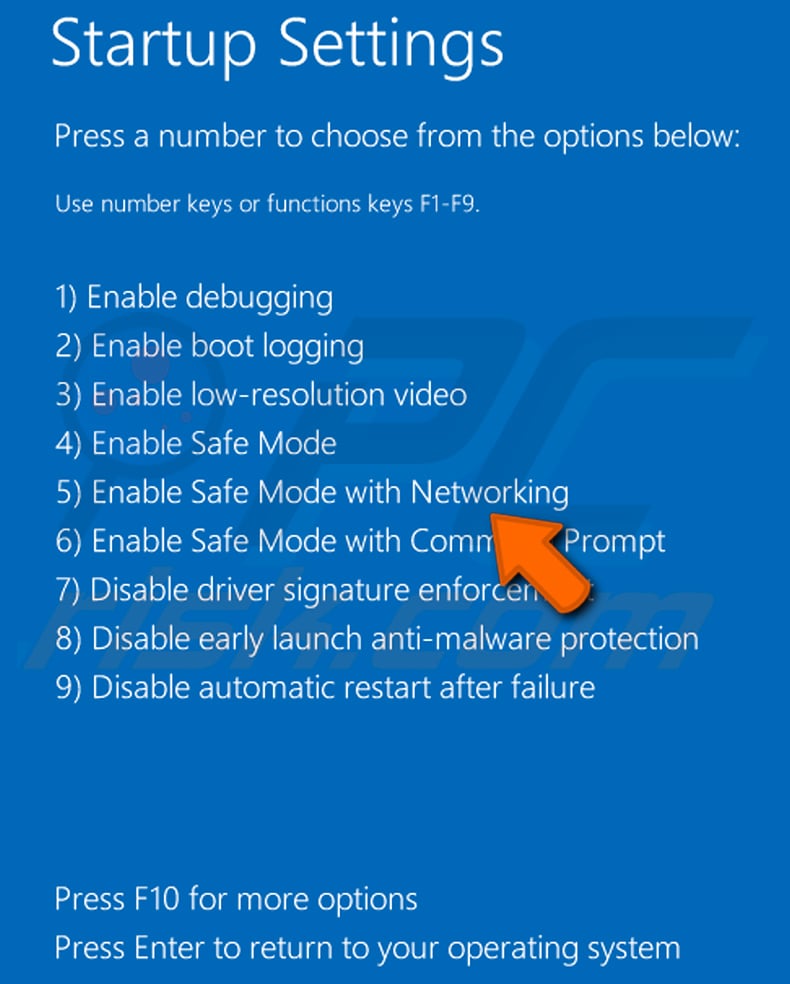
Video showing how to start Windows 10 in "Safe Mode with Networking":
 Extract the downloaded archive and run the Autoruns.exe file.
Extract the downloaded archive and run the Autoruns.exe file.

 In the Autoruns application, click "Options" at the top and uncheck "Hide Empty Locations" and "Hide Windows Entries" options. After this procedure, click the "Refresh" icon.
In the Autoruns application, click "Options" at the top and uncheck "Hide Empty Locations" and "Hide Windows Entries" options. After this procedure, click the "Refresh" icon.

 Check the list provided by the Autoruns application and locate the malware file that you want to eliminate.
Check the list provided by the Autoruns application and locate the malware file that you want to eliminate.
You should write down its full path and name. Note that some malware hides process names under legitimate Windows process names. At this stage, it is very important to avoid removing system files. After you locate the suspicious program you wish to remove, right click your mouse over its name and choose "Delete".

After removing the malware through the Autoruns application (this ensures that the malware will not run automatically on the next system startup), you should search for the malware name on your computer. Be sure to enable hidden files and folders before proceeding. If you find the filename of the malware, be sure to remove it.
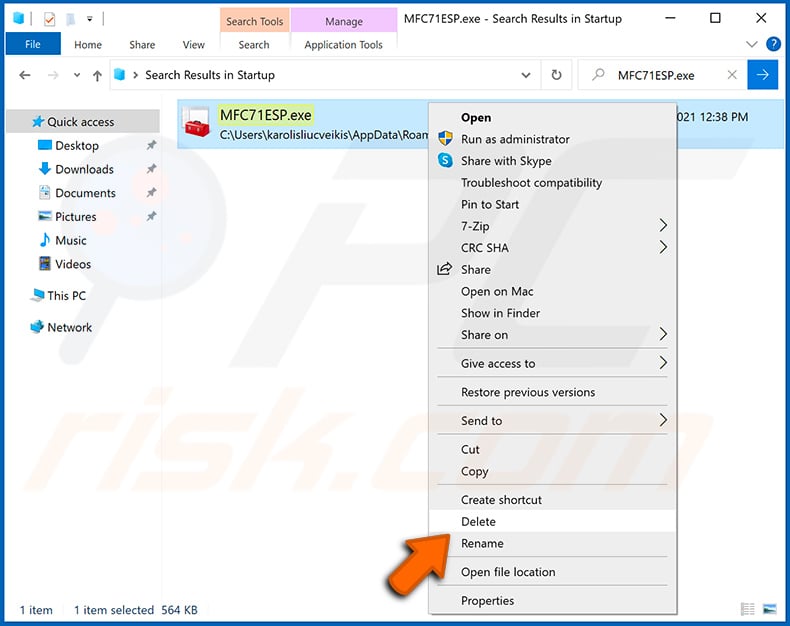
Reboot your computer in normal mode. Following these steps should remove any malware from your computer. Note that manual threat removal requires advanced computer skills. If you do not have these skills, leave malware removal to antivirus and anti-malware programs.
These steps might not work with advanced malware infections. As always it is best to prevent infection than try to remove malware later. To keep your computer safe, install the latest operating system updates and use antivirus software. To be sure your computer is free of malware infections, we recommend scanning it with Combo Cleaner Antivirus for Windows.
Frequently Asked Questions (FAQ)
My computer is infected with PhantomStealer, should I format my storage device to get rid of it?
Completely formatting a device is usually not needed. Threats like PhantomStealer can typically be removed with trusted antivirus or anti-malware programs, such as Combo Cleaner.
What are the biggest issues that malware can cause?
It can steal sensitive data, inject additional payloads (infect computers with more malware), encrypt files, cause system instability, or perform other malicious actions.
What is the purpose of PhantomStealer?
The purpose of PhantomStealer is to steal sensitive information from infected devices. This can include passwords, browser data, cryptocurrency wallet data, information saved in the clipboard, credit card details, files, and more.
How did PhantomStealer infiltrate my computer?
PhantomStealer is dropped through a malicious loader called JSGuLdr. A JScript file triggers PowerShell, which downloads encrypted files from Google Drive, decodes them in memory, and injects PhantomStealer into the legitimate msiexec.exe process to help it avoid detection. Although the exact initial infection method is unknown, it may spread through malicious emails, fake support pages, pirated software, harmful ads, cracked tools, vulnerabilities, or P2P downloads.
Will Combo Cleaner protect me from malware?
Yes, Combo Cleaner can detect and remove nearly all known malware. However, advanced malware often hides deep within the system, so it is important to perform a full system scan.
Share:

Tomas Meskauskas
Expert security researcher, professional malware analyst
I am passionate about computer security and technology. I have an experience of over 10 years working in various companies related to computer technical issue solving and Internet security. I have been working as an author and editor for pcrisk.com since 2010. Follow me on Twitter and LinkedIn to stay informed about the latest online security threats.
PCrisk security portal is brought by a company RCS LT.
Joined forces of security researchers help educate computer users about the latest online security threats. More information about the company RCS LT.
Our malware removal guides are free. However, if you want to support us you can send us a donation.
DonatePCrisk security portal is brought by a company RCS LT.
Joined forces of security researchers help educate computer users about the latest online security threats. More information about the company RCS LT.
Our malware removal guides are free. However, if you want to support us you can send us a donation.
Donate
▼ Show Discussion